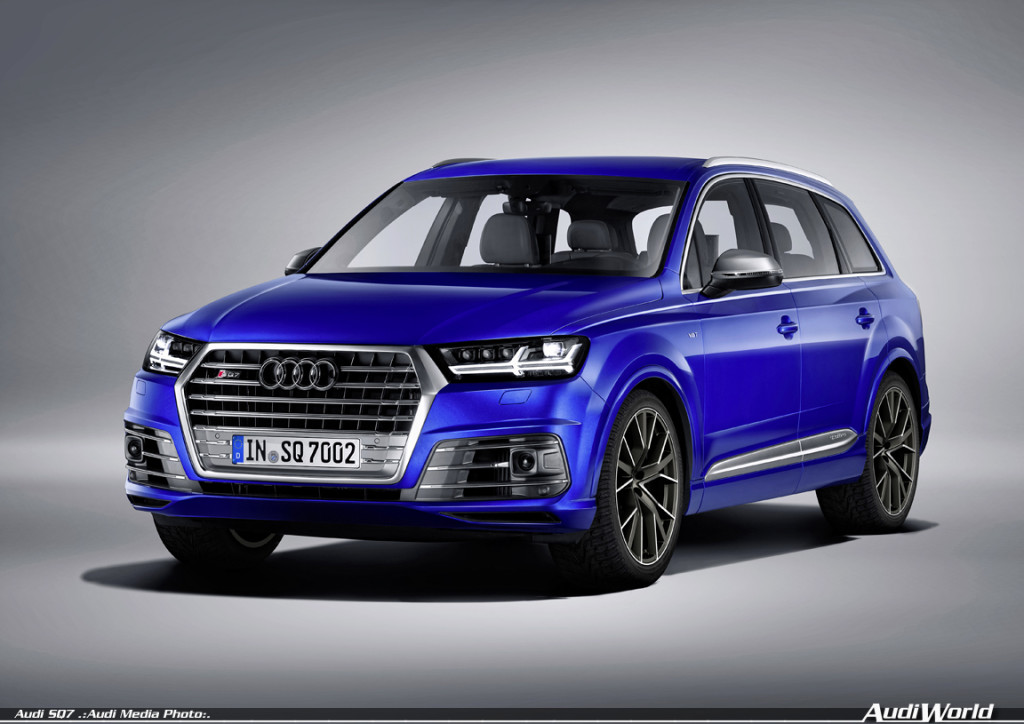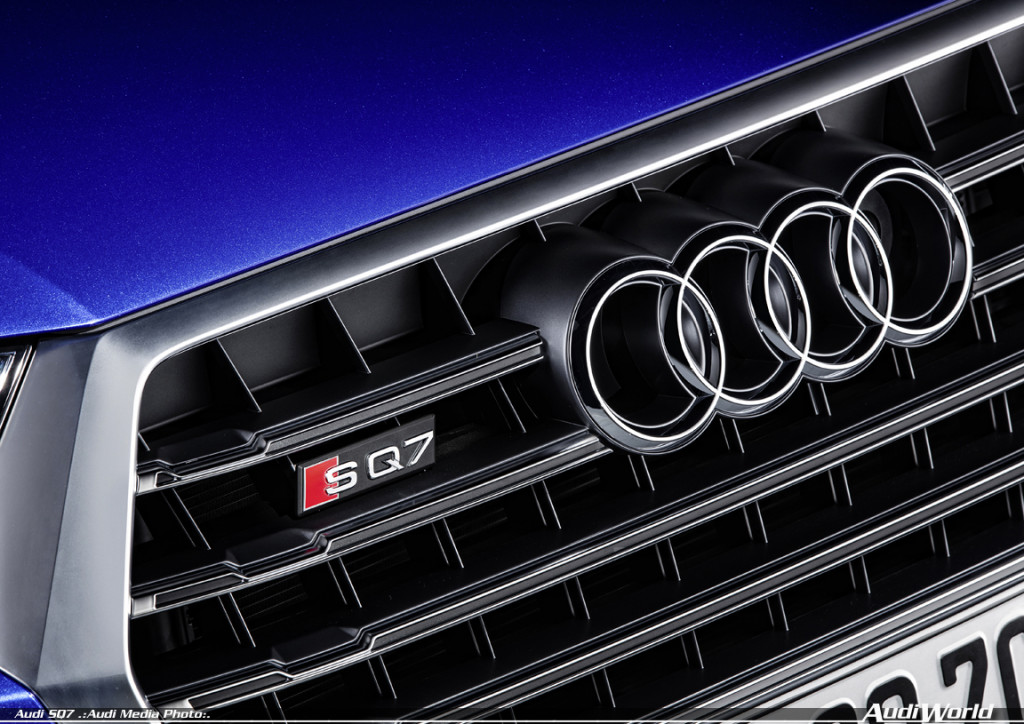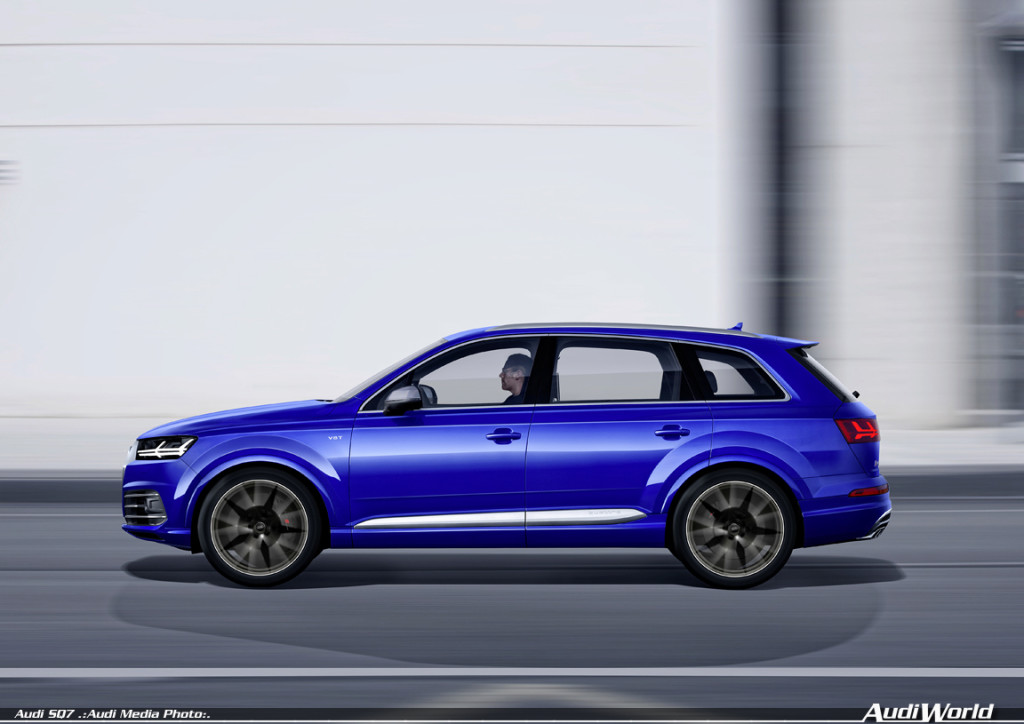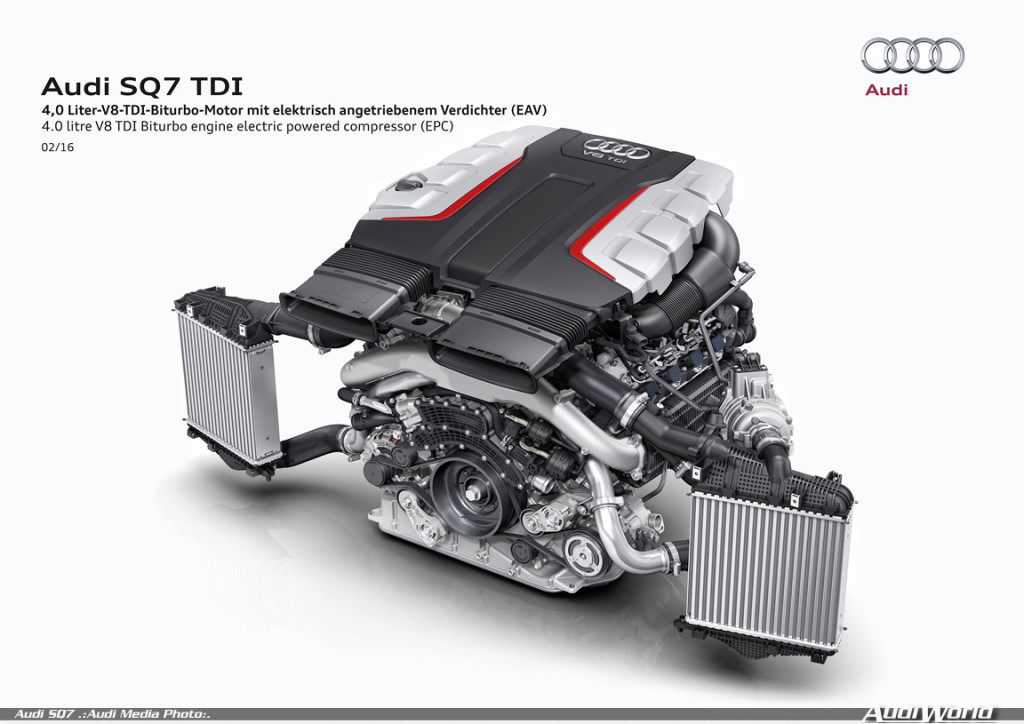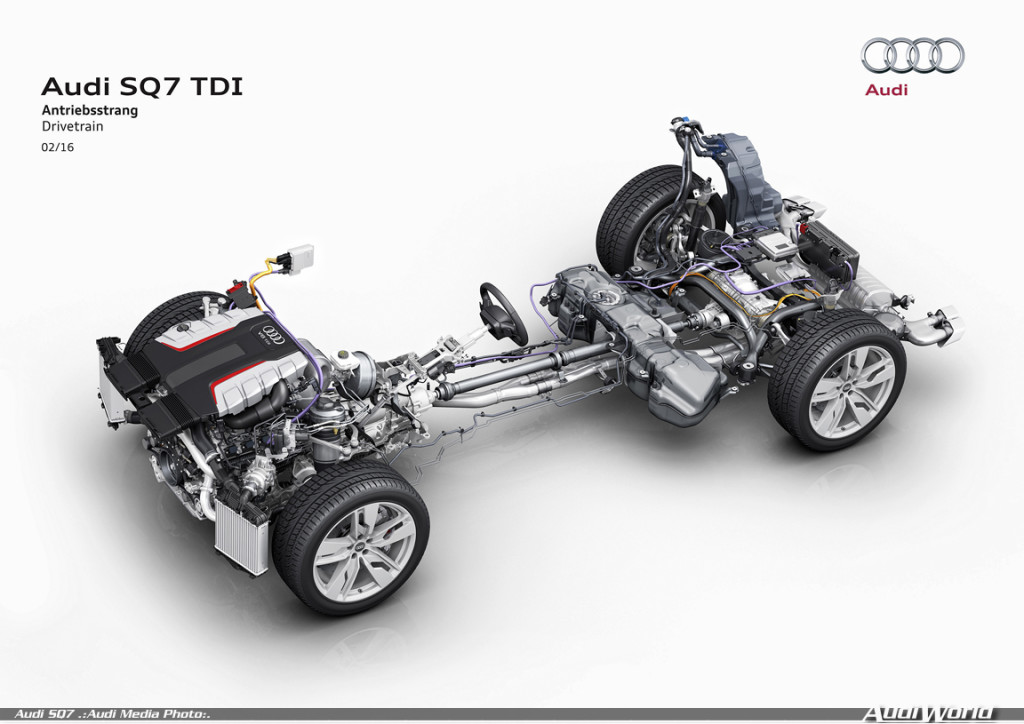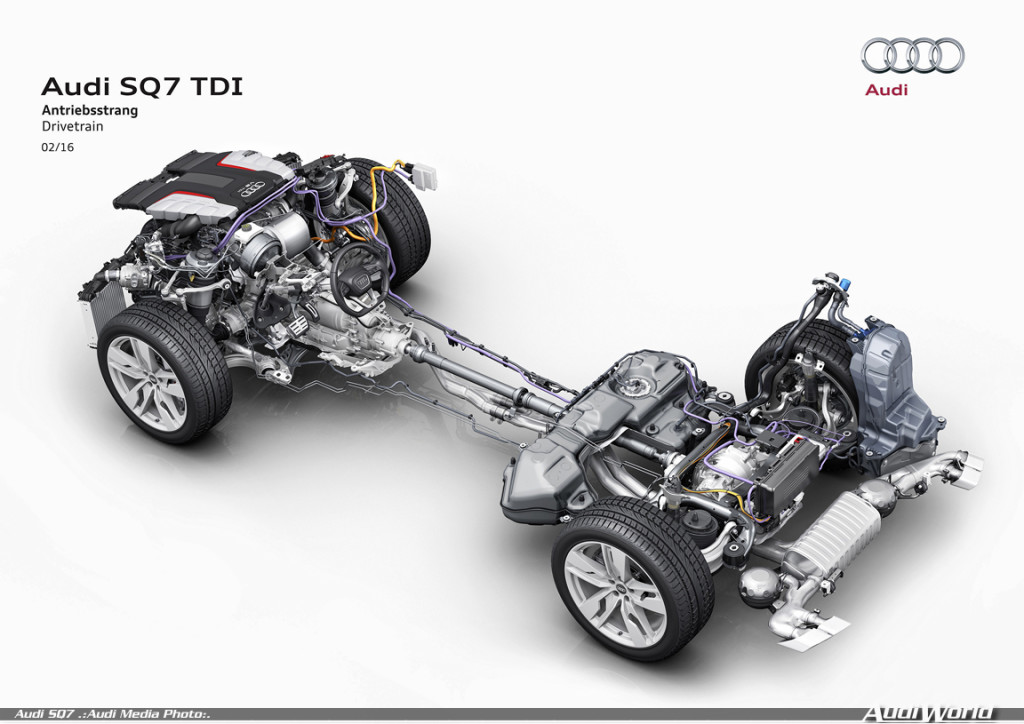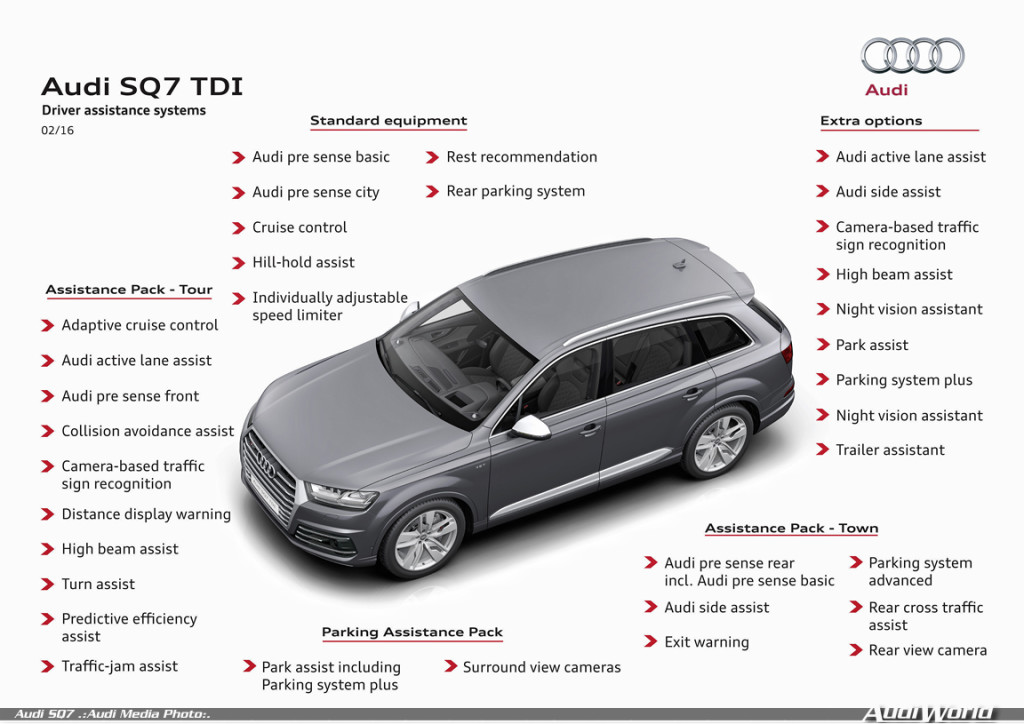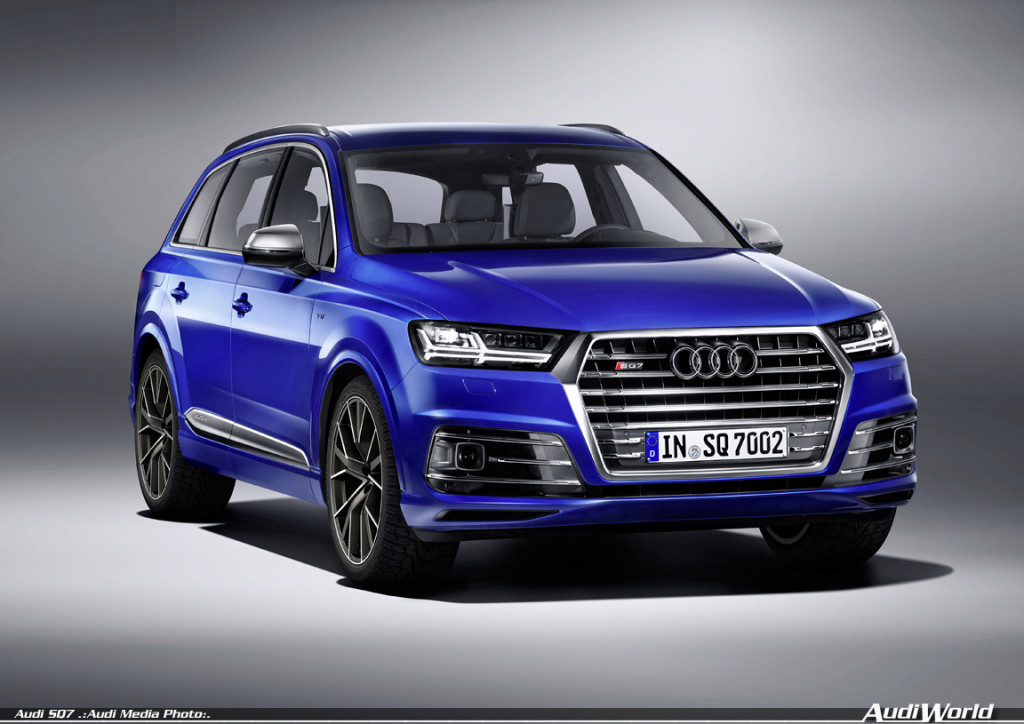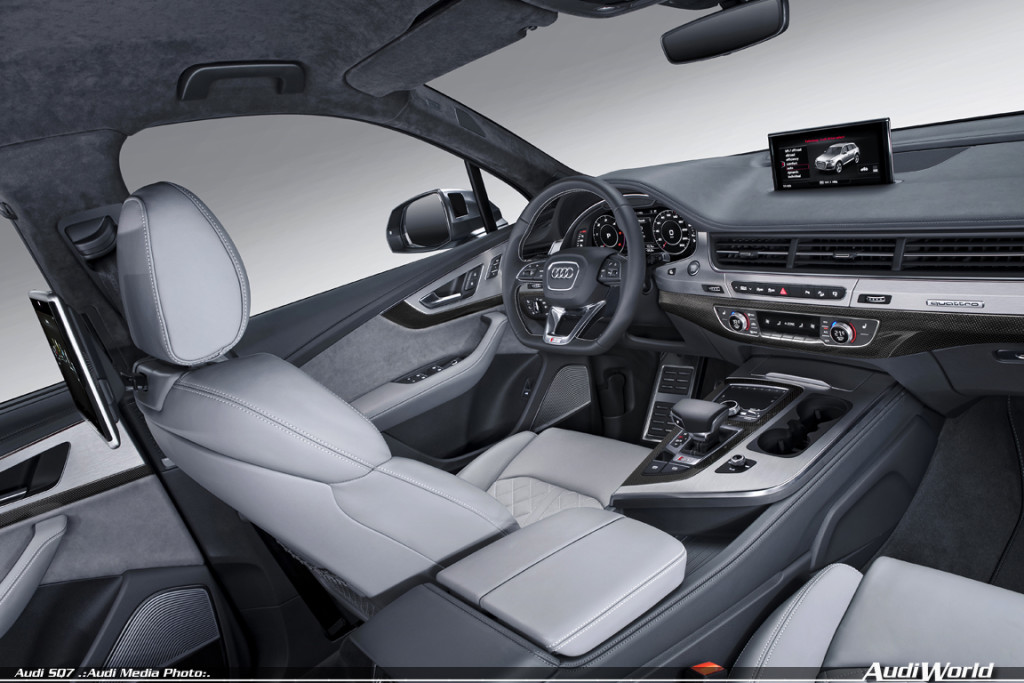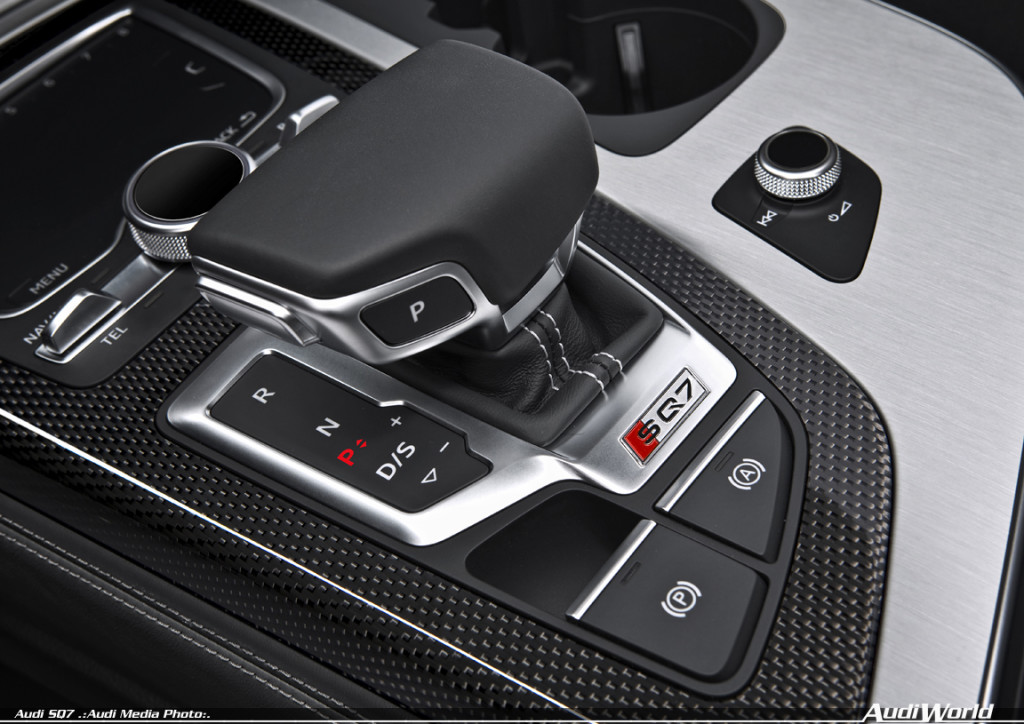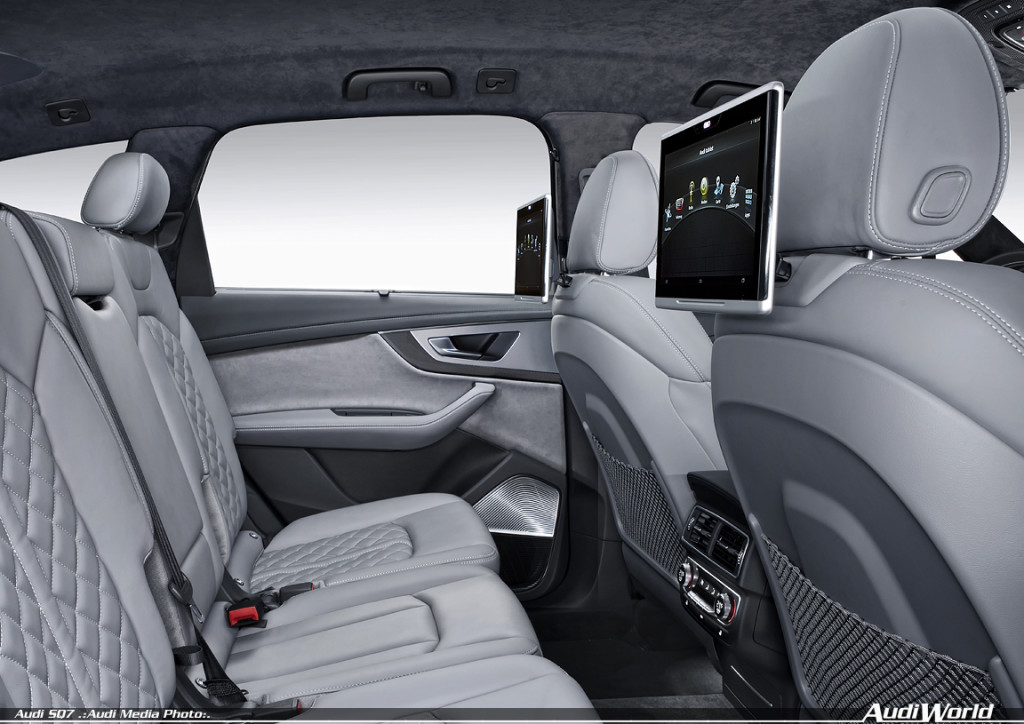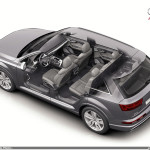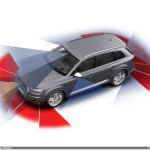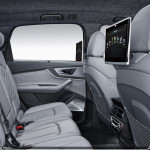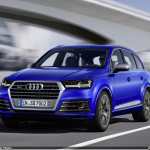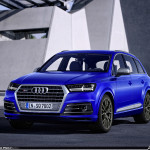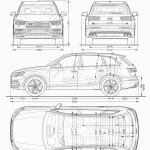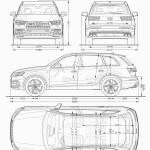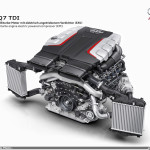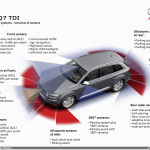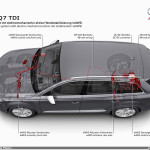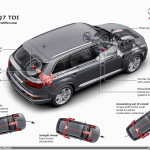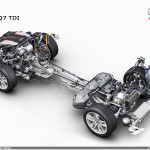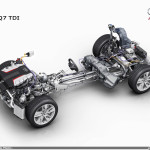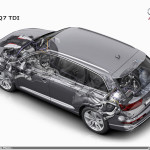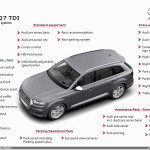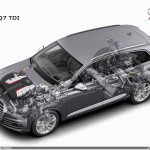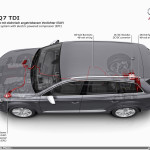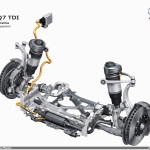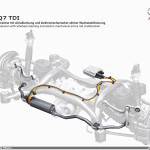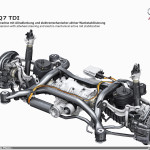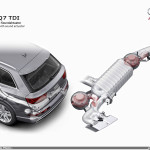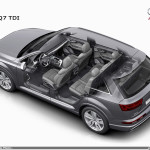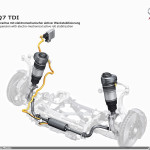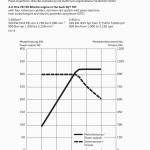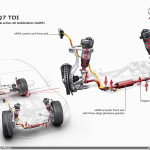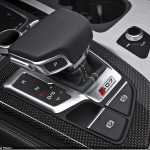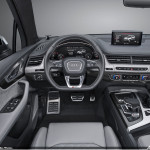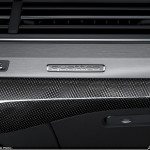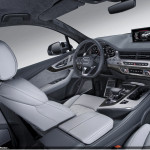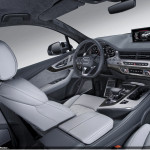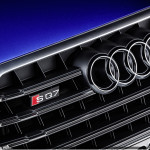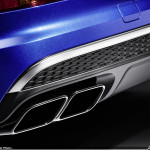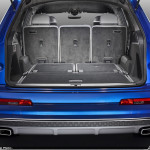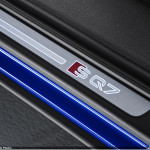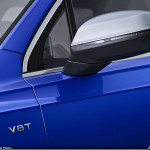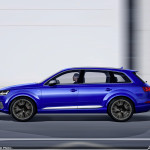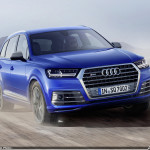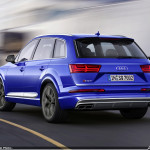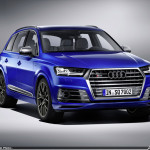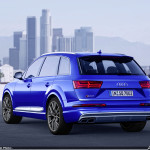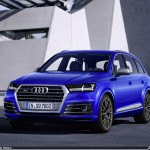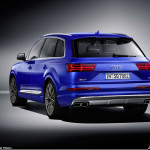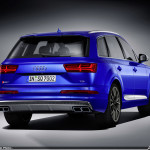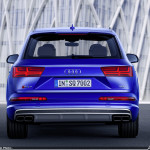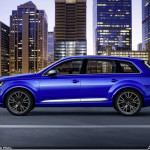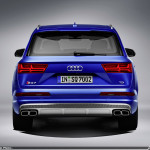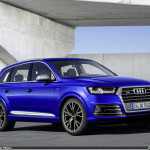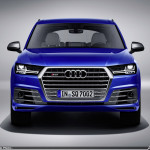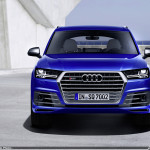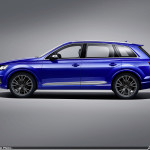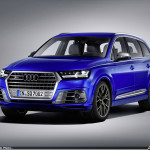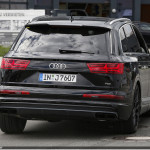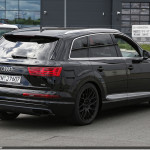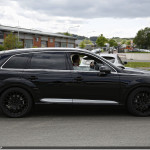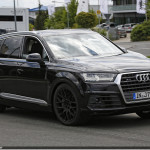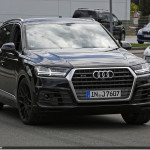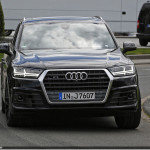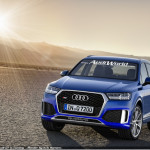The Audi SQ7 TDI: first S model of the series
The Audi SQ7 TDI, the top model of the new Q7 family, is the most powerful and fastest diesel SUV on the market. Its new 4.0 TDI engine features a world first: An electric powered compressor helps it to outstanding drive-off performance. Yet it consumes just 7.2 liters of fuel per 100 kilometers (32.7 US mpg). The SQ7 TDI also leads the competition in other areas of technology.
“In the SQ7 TDI, we are presenting a brand new engine: a dynamic four-liter V8 with the consumption figures of a six-cylinder,” said Dr. Stefan Knirsch, Audi Board Member for Technical Development. “Its electric powered compressor is a world first. It draws its power from a 48 volt electrical subsystem, which also supplies the new, electromechanical active roll stabilization. The Audi SQ7 TDI is also the technology leader with respect to assistance systems, chassis and connectivity,” added the Audi Board Member.
Leader of the pack: the new Audi SQ7 TDI
Say goodbye to turbo lag. With its electric powered compressor, the Audi SQ7 TDI* storms ahead with full power the moment the accelerator is depressed. It corners as nimbly as a sports sedan, but at 5.07 meters (16.6 ft) in length offers room for up to seven persons. When it comes to assistance systems, the SUV is the world champion in its segment.
A push of the red-rimmed start button and the V8 diesel comes to life with a deep rumble that promises real power: 435 hp and 900 Newton meters (663.8 lb-ft) from 1,000 rpm. The SQ7 TDI delivers full power right away thanks to a world’s first: the electric powered compressor that supports the two turbochargers at low engine speeds. Turbo lag – that’s history. The energy is provided by the 48 volt electrical subsystem, a new technology in this segment. The 100 km/h (62.1 mph) mark falls in less than five seconds, and acceleration continues up to 250 km/h (155.3 mph). This doesn’t mean that the SUV is particularly thirsty, however. It consumes on average just 7.2 liters per 100 kilometers(32.7 US mpg).
With the innovative, electromechanical active roll stabilization, cornering
is just as much fun as in a sports sedan. The SQ7 TDI can be driven even faster through sharp corners and remains stable at the limit thanks to the sport differential. All-wheel steering allows the 5.07 meter 16.6 ft) long SUV to be easily maneuvered into parking spaces or around corners. Standard all-wheel drive is at the ready for both snowy mountain passes and off-road adventures. No matter how rough the road may be, the air suspension with a continuously variable, electronically controlled damper system ensures that the passengers don’t notice a thing.
The choice of 24 assistance systems is unmatched in the segment. In slow-moving traffic on well-paved roads, the traffic jam assist can take over the steering at speeds up to 65 km/h (40.4 mph) – a pre-stage of piloted driving. On top of that, the SQ7 TDI helps to stay in the lane, brakes in hazardous situations, monitors oncoming traffic when turning left and detects pedestrians and animals in the dark.
The infotainment line up is also top-notch. Audi equips the SQ7 TDI with a sophisticated system with a large touchpad. The driver can control it using a free text search function and natural voice commands. To call a contact, the driver can just say “I want to call Peter Miller.” The system also has a quick answer for questions like “Where is the closest gas station?” That is both convenient and safe. An 8.3-inch monitor or the all-digital Audi virtual cockpit visualize it all. Its 12.3-inch color display is the groundbreaking alternative to the conventional dial instruments and presents all information as tack-sharp graphics. If desired, a head-up display projects data from the assistance and navigation systems onto the windshield in the driver’s direct field of vision. For audio enthusiasts, Audi offers the optional Bose sound system and Bang & Olufsen Advanced Sound System with 3D sound. Loudspeakers in the A-pillars depict the spatial dimension of height.
The SQ7 TDI goes online with an LTE module. In addition to accessing parking and traffic information, drivers can tweet and view the navigation map using Google Earth and Google Street View. The flat rate data plan required for this is included thanks to the new SIM card that is permanently installed in the vehicle. It also permits roaming in most European countries, which is very practical while on vacation. The Wi-Fi hotspot connects the passengers’ smartphones and tablets to the world wide web. But that’s not all. Drivers can use the Audi MMI connect app on their smartphone or smartwatch to lock and unlock their SQ7 TDI or to call up where they parked and the status of the car.
Orders for the Audi SQ7 TDI will be accepted in Europe beginning this spring. Prices in Germany start at 89,900 euros. Compared to the Q7*, it features an expanded range of standard equipment valued at roughly 10,000 euros.
Superior performance: the Audi SQ7 TDI
With 320 kW (435 hp) and 900 Newton meters (663.8 lb-ft) of torque, the Audi SQ7 TDI* is the most powerful diesel SUV on the market. It combines first-class performance with low consumption and maximum dynamics. A number of new technologies work in conjunction to make this possible.
“In many fields of technology, the Audi SQ7 TDI is at the head of its class,” said Dr. Stefan Knirsch, Audi Board Member for Technical Development. “Its newly developed V8 engine is the first in the world to use an electric powered compressor. This was made possible by the 48 volt electrical subsystem, which also provides the energy for the electromechanical active roll stabilization. With these innovations, the SQ7 TDI once again demonstrates Vorsprung durch Technik,” said the Audi Board Member.
Enormous power: 900 Newton meters and 320 kW (435 hp)
The Audi SQ7 TDI sets new benchmarks with 320 kW (435 hp) and 900 Newton meters (663.8 lb-ft) of torque – the latter between 1,000 and 3,250 rpm. It accelerates like a sports car from 0 to 100 km/h (62.1 mph) in 4.8 seconds; top speed is 250 km/h (155.3 mph) (governed). In the NEDC, it consumes just 7.2 liters per 100 kilometers (32.7 US mpg), which corresponds to CO2 emissions of 189 grams per kilometer (304.2 g/mi). The new eight-speed tiptronic provides for fast and efficient gear changes. At higher speeds, it allows coasting in neutral.
The new 4.0 TDI produces its power from a displacement of 3,956 cc. The two turbochargers are activated selectively according to the sequential charging concept. This combines high efficiency with dynamic power development. Control is via the Audi valvelift system (AVS), which here is making its debut in a TDI. At low engine speeds, only one conventional turbocharger is active. As rpm increases, the AVS activates the second exhaust valve in each cylinder, which until then had been closed. This directs hot exhaust to the second turbocharger, activating it.
New partner for the turbochargers: the electric powered compressor
An electric powered compressor (EPC), in which a compact electric motor drives the turbine wheel, supports the turbocharger whenever it cannot draw enough energy from the exhaust flow. The big diesel engine thus develops its immense power spontaneously with no turbo lag. The electric powered compressor provides the engine with the boost pressure needed for the dynamic delivery of power in less than 250 milliseconds. Its compressor wheel spins up to 70,000 rpm. The power is therefore available immediately when the driver presses the accelerator, which is also very apparent when starting off. The power for the electric powered compressor comes from a 48 volt electrical subsystem, another innovation in the Audi SQ7 TDI. A compact lithium-ion battery stores the energy.
The new V8 TDI features new high-tech solutions in all areas. Its intake side is on the outside; the exhaust side with the two turbochargers are in the inner V. This layout provides for short gas paths and spontaneous response. The common-rail system generates up to 2,500 bars of injection pressure. More fuel enters the combustion chamber, increasing specific output while simultaneously reducing emissions at part load. Continuously variable thermal management and sophisticated measures in the crankshaft and camshaft drive reduce friction.
From comfortable to dynamic: the chassis
The 4.0 TDI is combined with potent technologies in the Audi SQ7. The result is driveability that fulfills every expectation, from extremely comfortable cruising to dynamic handling. The quattro permanent all-wheel drive distributes power between the front and rear axle in a 40:60 ratio. The suspension links are largely made of lightweight aluminum.
The optional driving dynamics package comprising three technology modules enhances the sporty character of the Audi SQ7 TDI. The innovative, electromechanical active roll stabilization permits higher lateral acceleration and thus faster cornering. It draws its power from the new 48 volt electrical subsystem. When driving straight ahead, it provides for excellent ride comfort. An electric motor, which on an uneven road surface decouples the two halves of the stabilizer from one another, makes this possible. During sporty driving, the tubes are actively twisted against each other, resulting in taut, virtually neutral handling.
The sport differential provides for precise and stable handling during fast cornering. This superior control is achieved with variable torque between the rear wheels. When turning into or accelerating in a curve, the majority of the torque is directed to the outside wheel, pushing the car into the curve.
The third technology module is the all-wheel steering. To improve agility and stability, the rear wheels turn a few degrees in the same or opposite direction of the front wheels, depending on the situation. The large SUV thus becomes significantly even more nimble, and its turning radius smaller by up to one meter (3.3 ft) – quite noticeable during maneuvering and parking.
The electronic chassis platform central control unit provides for dynamic chassis control. The electronic chassis platform control unit continuously monitors the driving situation and in a cycle of just one millisecond adjusts the handling functions for the electromechanical active roll stabilization, the sport differential and adaptive air suspension. By comparison: A blink takes roughly 100 times as long.
Electromechanical power steering, the Audi drive select system and the adaptive air suspension with S-specific tuning are standard. The brake calipers are painted black (optionally red); an optional brake system with carbon fiber-ceramic discs will be available shortly after market launch. The SUV rolls on 20-inch wheels, with wheels up to 22 inches available
as an option.
Largest range in the segment: the driver assistance systems
The range of driver assistance systems available in the Audi SQ7 TDI is extremely diverse – 24 solutions are dedicated to composed, relaxed driving and safety. The standard Audi pre sense city offers a predictive warning and emergency braking system for accident avoidance and the protection of pedestrians. The adaptive cruise control maintains the interval to the car ahead at speeds between 0 and 250 km/h (155.3 mph).
In slow-moving traffic on well-paved roads, the traffic jam assist relieves the driver by temporarily taking over the steering in many situations. The predictive efficiency assistant uses precise information from the immediate vicinity for consumption-optimized driving. Other top innovations are the turn assist, park assist, exit warning and cross traffic assist rear.
Lightweight and distinctive: body and exterior design
Thanks to the systematic lightweight construction concept, the SQ7 TDI weighs just 2,270 kilograms (5,004.5 lb) without a driver. The body is a multimaterial construction. Hot-shaped and thus extremely strong sheets form the backbone of the occupant cell; the outer skin is made of aluminum. The center of mass is low – another factor for the sporty handling.
Numerous S-specific details hone the distinctive look of the 5.07 meter-long (16.6 ft) Audi SQ7 TDI. The Singleframe grille, air inlets, upper section of the mirror caps and elements of the door trim gleam in an aluminum look. The front apron is powerfully contoured; the roof edge spoiler is wider and more distinctive than that on the Q7*. A diffuser insert with an aluminum clasp encloses the four rectangular exhaust tailpipes. SQ7 TDI and V8T emblems adorn the front, the fenders and the rear. Precision-controlled Matrix LED technology is available as an alternative to the standard LED headlights. Dynamic turn signals are standard at the rear. Twelve paint finishes are available for the SUV.
Take your pick: five or seven seats
The Audi SQ7 TDI offers the largest interior in its class, with either five or seven seats. The second row comes standard with a three-section backrest with segments that can be folded down separately. The optional third row can be lowered into the vehicle floor electronically. In the five-seater model, the basic configuration of the luggage compartment boasts a volume of 805 liters (28.4 cu ft), and this can be increased up to 1,990 liters (70.3 cu ft). With a full contingent of passengers, the seven-seater model has a luggage capacity of 235 liters (8.3 cu ft). With the third row folded down, this becomes 705 liters (24.9 cu ft) with a maximum of 1890 liters (66.7 cu ft). A power tailgate is standard.
Driver and front passenger sit on sport seats that are covered as standard in Alcantara and leather, with Valcona leather available as an option. The optional sport seats plus come factory-fitted in Valcona leather with a diamond pattern. They also feature pneumatic adjustment of the seat and backrest side bolsters plus a variable head restraint.
Additional sporty accents are provided by instruments with gray dials and white needles, a special welcome screen and S badges. The LED interior lighting can be supplemented with an optional lighting package and ambient lighting that illuminates the door sill trims and additional contours on the center tunnel console. The latter can adjusted through a range of 32 colors. Besides the three color profiles familiar from the Q7, the SQ7 TDI also offers the Sport light profile in red/white.
Controls and displays: Audi virtual cockpit, new MMI system and
head-up display
The optional Audi virtual cockpit with its 12.3-inch display presents tack-sharp graphics and offers a choice of two views. In “Infotainment” mode, a central window dominates, providing a large stage for the navigation map, for example, or for lists in the phone, radio and audio areas. The tachometer and speedometer are displayed as small dial instruments on the right and left. In the classical view, the central window is smaller, and the instruments appear about as large as analog displays. The driver selects the information and the view modes, including a special SQ7 mode with boost indicator, via the multifunction steering wheel. Audi offers the top-of-the-line infotainment system, MMI navigation plus with MMI touch, as an option. It is controlled via a glass surface on the center tunnel console that provides haptic feedback after every input. The MMI logic allows for intuitive operation, including free text search and an integrated natural voice control system. A head-up display, which projects important information from the assistance and navigation systems or warnings onto the windshield, is also available.
High computing power: infotainment und Audi connect
The MMI navigation plus with MMI all-in-touch uses the second-generation modular infotainment platform. Its central computer comprises two main units – the radio car control unit and the MMX board (MMX = Multi-Media eXtension). The MMX board integrates – along with the working and flash memory – a super-fast processor that processes all online, media, voice control, navigation and telephone features.
Thanks to the integrated LTE module and the Wi-Fi hotspot, the passengers can surf at high speed with their mobile devices. Audi connect brings numerous online services on board, including traffic and parking information, fuel prices, Twitter and navigation with Google Earth and Google Street View. The Audi connect SIM permanently installed at the factory includes the flat rate data plan required to use these services. It will be available in the SQ7 TDI beginning this summer, and also permits roaming in most European countries. The driver can also purchase additional data packages for the Wi-Fi hotspot, independent of the integrated Audi connect services.
Cell phones with iOS and Android operating systems are integrated into the car via the Audi smartphone interface. Selected smartphone content can then be displayed on the MMI monitor. The Audi phone box couples smartphones with the on-board antenna and charges them inductively according to the Qi standard. Two Audi tablets are provided for the entertainment of the rear passengers. They can be clipped onto the front seatbacks and serve as a fully integrated Rear Seat Entertainment system.
The innovative Bose sound system with 3D sound is available as an option. Two of its 19 loudspeakers are mounted in the A-pillars and depict the spatial dimension of height. Or Audi will install the even more complex Bang & Olufsen Advanced Sound System with 3D sound.
Groundbreaking operation: control via app
The free Audi MMI connect app lets users transfer their calendar from their smartphone to the car. If requested, the system can speak the location, time and subject of the appointment, enter the location as a navigation destination and call the participant. With the personal POI search, interesting destinations from third-party databases can be stored in a myAudi account and transferred to the car’s navigation map via the Audi MMI connect app. Over 3,000 internet radio stations are available via the “Web radio” and “Media library” functions. This requires a data plan for the Wi-Fi hotspot.
The SQ7 TDI can also be equipped with the optional Audi connect safety & service package. This includes such functions as emergency call, online roadside assistance and Audi service request as well as remote functions that can be used with the MMI connect app on a smartphone, smartwatch or – in conjunction with the fourth generation Apple TV – from a television. Examples include locking and unlocking the car, checking where the car is parked and calling up the vehicle status.
Coming soon: price and availability
Ordering of the Audi SQ7 TDI will begin in spring of 2016 in Europe. The base price in Germany is 89,900 euros. Compared to the base model, it offers significantly more standard features valued at approximately 10,000 euros. In addition, the SQ7 TDI features the first electric powered compressor with 48 volt electrical subsystem ever used in a production vehicle.
At a glance
The Audi SQ7 TDI
Drive system
- Newly developed 4.0 TDI with eight cylinders, 320 kW (435 hp), maximum torque 900 Nm (663.8 lb-ft) of torque between 1,000 and 3,250 rpm.
- Sequential charging with two turbochargers, combined with an electric powered compressor for strong boost at low engine speeds
- 48 volt electrical subsystem to supply the electric powered compressor
- Sports car performance: from 0 to 100 km/h (62.1 mph) in 4.8 seconds, top speed 250 km/h (155.3 mph) (electronically governed).
- NEDC consumption 7.2 liters pro 100 Kilometer (32.7 US mpg), corresponding to 189 grams CO2 per kilometer (304.2 g/mi)
- Newly developed eight-speed tiptronic and quattro permanent all-wheel drive
Chassis
- Electromechanical active roll stabilization
- Five link suspension front and rear, electromechanical power steering
- Audi drive select and adaptive air suspension standard
- 20-inch wheels standard, optional wheels up to 22 inches
- Optional carbon fiber-ceramic brake discs will be available after market launch
- Optional driving dynamics package with three components: sport differential, all-wheel steering and electromechanical active roll stabilization
Driver assistance systems
- Wide range of driver assistance systems with many new developments – the world’s largest selection in the segment (24)
- Standard equipment: hold assist; Audi pre sense (basic/city); parking system, rear; cruise control and speed limiter; attention assist
- Tour package: left turn assist, adaptive cruise control, Audi active lane assist, pre sense front, collision avoidance assist, camera-based recognition of traffic signs, predictive efficiency assistant, traffic jam assist
- City package: Audi side assist, exit warning, pre sense rear, parking system plus, cross traffic assist rear, reversing camera
- Parking package: 360 degree camera, park assist
- Other options: trailer maneuver assist, high-beam assist, night vision assistant
Design, body and lighting
- 5.07 meters (16.6 ft) long, powerfully masculine formal idiom with sporty touch
- S-specific details on the front, flanks and rear, twelve paint finishes
- Standard LED headlights, optional Matrix LED
- Rear lights with dynamic turn signals
- Multimaterial body with ultra-high-strength steel and aluminum
- Curb weight: 2,270 kilograms (5,004.5 lb) (without driver)
Interior
- Largest interior in the segment, with choice of five or seven seats
- Luggage compartment (five-seater model) 805 to 1,990 liters (28.4 to 70.3 cu ft), power tailgate
- Sport seats for driver and front passenger, optional sport seats plus
- Sporty and refined interior, S-specific details, optional Audi design selection Kodiak brown with sport seats plus in Valcona leather and diamond pattern
- Ambient lighting with S-specific “Sport” profile
Display and controls
- Intuitive MMI control concept including free text search, optional top infotainment system MMI navigation plus with touchpad MMI all-in-touch (control with haptic feedback and MMI center display)
- Multifunction steering wheel and natural voice control system
- Optional all-digital Audi virtual cockpit and head-up display
Infotainment and Audi connect
- MMI navigation plus with 8.3-inch monitor and LTE module for fast online connection
- Computing power of the modular infotainment platform (MIB2)
- Audi connect SIM, WI-Fi hotspot data package and EU-wide roaming
- Audi MMI connect app
- Audi connect safety & service
- Audi tablets as a mobile Rear Seat Entertainment system
- Audi smartphone interface for Android and iOS
- Audi phone box with wireless charging
- Sound systems from Bose and Bang & Olufsen with 3D sound
Engine
The all-new 4.0 TDI generates its power from a displacement of 3,956 cc, combining superior performance with low consumption. With 320 kW (435 hp) and 900 Nm (663.8 lb-ft) of torque between 1,000 and 3,250 rpm, the SUV sets new benchmarks in the segment. The V8 diesel engine accelerates the Audi SQ7 TDI from 0 to 100 km/h (62.1 mph)in 4.8 seconds, and on up to an electronically governed top speed of 250 km/h (155.3 mph). In the NEDC, however, it consumes just 7.2 liters pro 100 Kilometer (32.7 US mpg), corresponding to 189 grams CO2 per kilometer (304.2 g/mi).
The new 4.0 TDI is a biturbo that is supported in the lower range by an electric powered compressor (EPC). Its two exhaust-gas turbochargers feature a variable turbine geometry and produce up to 2.4 bars of boost pressure (relative). The EPC supports the turbochargers whenever the exhaust gas provides too little energy for the rapid development of power.
The electric powered compressor is placed in a bypass downstream of the intercooler, i.e. close to the engine. Instead of a turbine wheel, it houses a compact electric motor. It accelerates the engine’s compressor wheel up to 70,000 rpm in less than 250 milliseconds. With the support of the electric powered compressor, the power of the 4.0 TDI is always available spontaneously and without delay when the accelerator is depressed,
even at low engine speeds. When driving off, the SUV immediately jumps out to a lead of several meters over its competitors When driving with a focus on comfort, the electric powered compressor technology prevents an unnecessarily large number of downshifts, thus keeping the rev level low. Sporty drivers will appreciate the passing power and immediate delivery of power when exiting a curve.
Output up to 13 kW: the new 48 volt electrical subsystem
The power for the electric powered compressor can be as high as 7 kW. It is drawn from a 48 volt electrical subsystem, another groundbreaking innovation in the Audi SQ7 TDI. A compact lithium-ion battery in the lower level of the luggage compartment stores around 0.5 kWh of energy and delivers a peak output of up to 13 kW. A DC/DC converter provides the connection to the 12 volt electrical system, which is supplied with 3 kW of power from a novel, efficiency-optimized alternator.
Sequential charging: switching via the Audi valvelift system
The two exhaust-gas turbochargers, each of which is supplied with fresh air from both cylinder banks, are managed according to the sequential charging principle. Control is via the Audi valvelift system (AVS), which here is making its debut in a TDI engine. Electromagnetic actuators displace contour sleeves on the camshafts so that the exhaust valves are either activated or deactivated.
The exhaust, which each cylinder discharges from both exhaust valves, flows through separate channels within a dual-flow manifold system. Each exhaust valve supplies one of the two turbochargers. At low and intermediate load and rpm, the Audi valvelift system (AVS) keeps one valve closed so that the entire exhaust flow reaches the so-called “active” turbocharger. If engine speed increases to the range between 2,200 and 2,700 rpm, the respective second exhaust valve is opened. Now the second turbocharger will also be activated.
A recirculation valve ensures that it spins up quickly and reliably. The V8 TDI achieves its maximum output when both exhaust-gas turbochargers are spun up. Additional AVS units are located at the intake camshafts. Here two cam contours with different timings ensure optimal filling of the combustion chamber, both during EPC supported starts and at high engine speeds. At low engine speeds, combustion is stabilized. At high rpm, cylinder filling is optimized for the high specific engine output. The intake side of the 4.0 TDI is on the outside; the exhaust side with the turbochargers is located in the 90-degree inside V. The short gas paths support the spontaneous response. The common rail system develops fuel injection pressures up to 2,500 bar – a new top figure for a V diesel. The elevated pressure contributes to increasing the specific engine output while simultaneously achieving low emissions under part load. For a given injection duration, more fuel – and thus more chemical energy – can be injected into the combustion chamber and converted there with high specific efficiency to mechanical energy. Ignition pressure reaches the 200-bar mark in broad sections of the characteristic. Continuously variable thermal management and sophisticated measures in the crankshaft and camshaft drive reduce friction. The combination of a NOx storage-type converter combined with an SCR converter integrated into the diesel particulate filter ensures effective and efficient exhaust treatment. A sound actuator in the exhaust system amplifies the sonorous eight-cylinder sound. The driver can configure the sound via the Audi drive select system.
Drivetrain
The new eight-speed tiptronic is highly efficient. It changes gears extremely quickly and efficiently. An rpm-adaptive torsion damper balances out undesired engine vibrations to enable efficient driving at particularly low engine speeds.
The driver of the SQ7 TDI can have the new eight-speed tiptronic operate in automatic modes D and S or himself intervene by tapping on the elegant, flat-shaped selector lever on the console of the center tunnel or by using the standard-equipped paddles on the steering wheel. In both cases the commands are transmitted electrically – by wire – to the transmission.
The management of the eight-speed tiptronic uses the data provided by the optional MMI navigation plus to compute the best shift strategy on each section of the route. In cooperation with the optional predictive efficiency assistant and the adaptive cruise control, it switches to coasting if this will save fuel. One of the clutch mechanisms then opens at the wheel sets. This automatic coasting at idle can be experienced over a broad speed range between 160 km/h (99.4 mph) and roughly 50 km/h (31.1 mph).
With respect to road behavior, the Audi SQ7 TDI combines numerous talents, from highly comfortable cruising on the highway to dynamic handling on a mountain road. The compact and lightweight self-locking center differential is the heart of the quattro permanent all-wheel drive system, which is purely mechanical. Under normal driving conditions, the center differential, designed as a planetary drive, distributes the power between the front and rear axles in a 40:60 ratio. If a wheel on one of the axles slips, e.g. when on a slippery surface, the self-locking differential immediately directs the majority of the power to the axle with the better traction. If necessary, up to 85 percent of the drive torque can be directed to the rear axle or up to 70 percent to the front axle.
The chassis adheres to the principle of strict lightweight construction. Its five-link suspensions front and rear are made largely of aluminum. Electromechanical power steering, the Audi drive select dynamic handling system and the adaptive air suspension with S-specific tuning are standard.
The SQ7 TDI rolls standard on 20-inch wheels with size 285/45 tires. Alternatives range up to 22-inch tires from the Audi sport line from quattro GmbH. The brakes are big and powerful. Mounted on the front axle are internally ventilated, lightweight discs measuring 400 millimeters (15.7 in) in diameter. They are gripped by black (optionally red), six-piston calipers with S logos. A brake system with particularly lightweight and abrasion-resistant carbon fiber-ceramic disks will follow shortly after the market launch.
Innovative technology modules: the driving dynamics package
Upon request, Audi will equip the SQ7 TDI with a driving dynamics package comprising three technology modules: the sport differential, all-wheel steering and electromechanical active roll stabilization.
During sporty cornering, the sport differential ensures that steering commands are carried out precisely and stably. The superior control is achieved by means of a variable torque between the wheels of the rear axle.
A software function continuously computes the ideal distribution with respect to handling. When turning into or accelerating in a curve, the majority of the torque is directed to the outside wheel, pushing the car into the curve. Before the rear end can break out, the vehicle is stabilized and thus easily controlled.
Another optional system for the new Audi SQ7 TDI is all-wheel steering. Installed at the rear axle is a steering system with electrical spindle drive and two track rods that turns the rear wheels a few degrees in the same or opposite direction relative to the front wheels, depending on the situation. At low speeds, the rear wheels turn in the opposite direction. The large SUV thus becomes significantly even more agile, and its turning radius smaller by up to one meter (3.3 ft) – as noticed quite clearly by the driver during maneuvering and parking. At slow speeds between five and 15 km/h (3.1 – 9.3 mph), the oppositely directed steering can range up to five degrees. At higher speeds the rear wheels follow the movement of the front wheels up to an angle of 3.5 degrees. Turning in the same direction improves the steering response and further increases stability in evasive maneuvers.
The third component is the electromechanical active roll stabilization, another innovation from Audi. With this system, a compact electric motor at the front and the rear axle with a three-stage planetary gearbox separates the two halves of the stabilizer. On an uneven road surface, they are decoupled from one another, which improves ride comfort. During sporty driving, the tubes are actively twisted against each other. That significantly reduces body roll, i.e. the lean of the car. Together with the planetary gear, an electric motor produces anything up to 1,200 Nm (885.1 lb-ft) of torque.
The effect is taut, sporty handling: The car leans less in bends, and the tendency to understeer is further reduced. This enables higher lateral acceleration and thus faster cornering. The front and rear stabilizer can be adjusted independently of each other. This active distribution of power between the front and rear axles significantly enhances steering precision and the agility of the automobile.
Like the electric powered compressor, the electromechanical active roll stabilization draws its drive power from the new 48 volt electrical subsystem, making it more powerful and faster than a conventional hydraulic system. The new electromechanical active roll stabilization technology from Audi can also recuperate. If the wheels on one axle are deflected to greatly differing extents on bumps in the road, they excite the stabilizer – the electromechanical active roll stabilization motor now converts each impulse into electrical energy. This energy is stored in the 48 volt electrical subsystem’s lithium-ion battery, ensuring that the overall energy balance of the electromechanical active roll stabilization is significantly more favorable than that of a hydraulic system. Because it requires no oil, the electromechanical active roll stabilization is also maintenance-free and environmentally friendly.
Dynamic control: the electronic chassis platform
The adaptive air suspension and now for the first time also the electromechanical active roll stabilization and sport differential are connected to the central control unit called the electronic chassis platform. This is highly precise and adapts to the situation at hand. Computation and adjustment of the handling functions take place in a one-millisecond cycle. By comparison: A blink takes roughly 100 times as long. The electronic chassis platform sends the computed values for the mechanical adjustment to the roll stabilization and/or to the sport differential and adjusts the air suspension setting.
Driver assistance systems
The Audi SQ7 TDI sets new standards with 24 driver assistance systems. All of the solutions are new or have been largely redeveloped. The optional systems are available either individually or in the City, Parking and Tour packages.
The adaptive cruise control plays a central role. It maintains the interval to the car ahead at speeds between 0 and 250 km/h (155.3 mph). On well-paved roads, the traffic jam assist relieves the driver in slow-moving traffic up to 65 km/h (40.4 mph) by temporarily taking over the steering in addition to acceleration and braking. The predictive efficiency assistant helps by offering drivers situation-specific tips on how to save fuel. It evaluates information from the immediate vicinity of the car. If the driver wishes, the system controls the coasting of the eight-speed tiptronic. On highways it can improve fuel economy by up to ten percent in this way.
Important safety features include the park assist, cross traffic assist rear, exit warning system, collision avoidance assist and turn assist as well as the Audi pre sense systems. At speeds up to 85 km/h (52.8 mph) the standard solution Audi pre sense city monitors the area in front of the SQ7 TDI for other vehicles and pedestrians. In a critical situation, the system warns the driver and initiates full braking, if necessary.
Additional assistance systems round out the range. These include camera-based recognition of traffic signs, the trailer maneuver assist, night vision assistant, Audi active lane assist, Audi side assist and the 360 degree cameras.
Body and exterior design
Thanks to Audi’s systematic lightweight construction concept, the SQ7 TDI weighs just 2,270 kilograms (5,004.5 lb) without a driver while offering strong performance with respect to crash safety, torsional rigidity and acoustic comfort. In the multimaterial body, hot-shaped and ultra-high-strength sheets form the backbone of the occupant cell.
The outer skin is made of aluminum. The drag coefficient is just 0.34, and the center of gravity is low. This factor also sharpens the sporty character.
The Audi SQ7 TDI impresses with its masculine formal idiom. At 5.07 meters (16.6 ft), it is roughly as long as the base model. It is 1.97 meters (6.5 ft) wide, 1.74 meters (5.7 ft) tall and has a wheelbase of 3.00 meters (9.8 ft). All lines and surfaces are precise and concise. The sculpted Singleframe radiator grille, the distinctively highlighted wheels and the flared quattro-styled blisters emphasize the Audi genes.
Specific details hone the look of the new top model, for which there is a choice of 12 paint finishes. The Singleframe grill, the air inlets with their dual slats, the upper section of the exterior mirror housings and elements of the door trim gleam in an aluminum look. The front apron is powerfully contoured; chiseled sills accentuate the flanks of the Audi SQ7 TDI. The roof edge spoiler is wider and more distinctive than that of the Q7*. A diffuser insert with an aluminum clasp encloses the four rectangular exhaust tailpipes. SQ7 TDI and V8T emblems adorn the front, the fenders and the rear.
LED headlights and dynamic rear turn signals are standard. Optionally available is Matrix LED technology, with which the high beam for each headlight is split up into 30 individual light-emitting diodes. With their highly precise control system, they illuminate the road superbly without blinding oncoming traffic. The Matrix LED headlights also include intelligent cornering lights.
Interior
The Audi SQ7 TDI offers its passengers the largest interior in its segment. Customers can choose five or seven seats. The sport seats for the driver and front passenger offer a wide range of power adjustments. Optionally available are sport seats plus with pneumatic side bolster adjustment on the seatbacks and seat cushions as well as variable head restraints. The customized contour seats with seat ventilation and optional massage function offer even more comfort.
The three-piece backrests in the second row can be folded down separately, and the optional third row can be lowered electronically into the floor of the SQ7 TDI. In the five-seater model, the basic configuration of the luggage compartment boasts a volume of 805 liters (28.4 cu ft), and this can be increased up to 1,990 liters (70.3 cu ft). With a full contingent of passengers, the seven-seater model has a luggage capacity of 235 liters (8.3 cu ft). With the third row folded down, this becomes 705 liters (24.9 cu ft) with a maximum of 1890 liters (66.7 cu ft). A power tailgate is standard.
The SQ7 TDI ups the ante with elegant interior details. The standard analog instruments have gray dials and white needles. A red ring surrounds the start-stop button, and the pedals are plated with stainless steel. The center tunnel console, the optional sport leather steering wheel flattened at the bottom, the key and the optional illuminated door sill trims bear SQ7 logos. The interior lighting shines in LED technology. There is an optional lighting package and ambient lighting, which can be adjusted over a range of 32 colors. Besides the three color profiles familiar from the Q7, the SQ7 TDI also offers the Sport light profile in red/white.
Black is the dominant color in the interior. The two-piece inlays combine brushed aluminum with chrome paint finish, slate gray. Carbon Atlas, piano finish and other materials are available from quattro GmbH. The sport seats come standard in Alcantara and leather, with Valcona leather available as an option. The sport seats plus come factory-fitted with the high-grade leather upholstery, including a diamond pattern.
A special highlight is the Audi design selection Kodiak brown. It comprises the sport seats plus with Valcona leather upholstery and diamond pattern plus an Alcantara headlining in black. The inlays are made of aluminum and Carbon twill, copper – a type of binding for woven materials. The instrument panel, the center tunnel console and the top shoulders of the doors are covered in black leather with contrasting stitching. Customers can also choose the elegant design selection Murillo brown.
Controls and displays
Audi is taking a new approach to controls with the optional MMI navigation plus with MMI all-in-touch. The driver can enter characters on the large touchpad or perform multi-finger gestures to zoom in on the map, for example. The system provides acoustic and haptic feedback after each command. The MMI logic with its flat hierarchies and free text search is oriented on modern smartphones. The natural voice control system understands a large number of expressions from everyday speech.
The optional Audi virtual cockpit with 12.3-inch display presents its information in brilliant, high-resolution graphics. It displays a special screen when the car is started and a special S design when driving. These elements also appear on the monitor of the MMI navigation plus with MMI all-in-touch. The driver uses the multifunction steering wheel to choose the view in the virtual cockpit. Audi supplements this with a
head-up display. It projects important information, such as speed and navigation data onto the windshield in the driver’s direct field of vision.
Infotainment and Audi connect
The top infotainment system uses the second-generation modular infotainment platform. Its central computer comprises two main units – the radio car control unit and the MMX board (MMX = Multi-Media eXtension). The MMX board integrates – along with the working and flash memory –
a super-fast processor that processes all online, media, voice control, navigation and telephone features. The board is a plug-in module. Audi can keep it at the state of the art during the development process and thus bring innovations in consumer electronics into the car at an early stage.
MMI navigation plus with MMI all-in-touch integrates an LTE module, making it easy to connect the SQ7 TDI to the internet. A Wi-Fi hotspot enables the passengers to surf with up to eight mobile devices. The optional Audi connect package brings numerous online services on board, including traffic and parking information, Twitter and navigation with Google Earth and Google Street View.
The flat rate data plan required for this is included, because beginning with the market launch of the SQ7 TDI, European customers also get the new Audi connect SIM together with the Audi connect package. With the embedded (permanently installed) SIM, the driver no longer needs to complete an activation process. Crossing borders is also more convenient with the new SIM. It also permits roaming in most European countries, as it can automatically access the provider for the specific country, as necessary. This eliminates high, country-specific roaming charges when crossing borders and inconvenient confirmations for the customer.
Data packages can also be ordered for the Wi-Fi hotspot, independent of any integrated Audi connect services. Provided the customer chooses the appropriate package, data transfer also continues automatically at a fixed price when crossing a national border, i.e. when changing networks. Customers can flexibly book data packages for the Wi-Fi hotspot via a special web portal or, after initial registration, directly in the car – quickly and conveniently via the MMI system. Drivers can also use their own SIM card in the car and establish Wi-Fi internet access through a separate cellular provider. In this case, the data volume used by the Audi connect services will also be charged to the customer’s SIM card and the Audi connect SIM temporarily deactivated. The new product is the first result of a collaboration between Audi and the Irish company Cubic Telecom, a worldwide leading supplier of seamless connectivity solutions. The Audi connect SIM is activated for a period of three years from the purchase of a new car. An Audi service partner can reactivate it at the end of this period for a fee.
The free Audi MMI connect app brings other services on board. For example, the appointment calendar on the smartphone can be transferred to the MMI. The meeting location can be used as a navigation destination; the telephone number of the person to be met can be dialed directly and saved in the vehicle as a contact. In addition, users can have the system speak the location, time and subject of the appointment. With the personal POI search, customers can also store interesting destinations from third-party databases in their myAudi account and transfer them from there to the car’s navigation map via the Audi MMI connect app.
The functions “Web radio” and “Media library” can be used to receive more than 3,000 internet radio broadcasts, save favorites to a mobile phone and play them back from there via the MMI navigation plus system. The app also provides access to the media library stored on the user’s smartphone. This requires a data plan for the Wi-Fi hotspot.
The optional Audi connect safety & service package is also available for the SQ7 TDI. It offers functions such as emergency call, online roadside assistance and Audi service request. With the remote services included in the package, customers can use the MMI connect app on the smartphone to lock and unlock the car, check where the car is parked and call up the vehicle status. The app can also be used on a smartwatch or, in combination with the fourth-generation Apple TV, on the television.
The Audi smartphone interface brings Apple Car Play and Android Auto into the car. If the customer connects an iOS or Android smartphone to the USB port (iOS from 7.1, Android from 5.0 Lollipop), the smartphone’s contents such as navigation, phone, music and select third party apps are offered in a separate MMI menu. They can be accessed conveniently by MMI or voice control.
Another highlight in the infotainment lineup is the Audi phone box. It charges smartphones inductively according to the Qi standard and couples them with the on-board antenna for optimal reception.
Two Audi tablets that can be fastened to the backs of the front seats provide entertainment for the rear passengers. Networked with the MMI navigation plus with MMI all-in-touch, they serve as Rear Seat Entertainment. At the end of the trip, the passengers can unclip the tablets and continue to use them outside the car.
The sound systems on board provide an extraordinary sound experience. The Bang & Olufsen Advanced Sound System with 3D sound comprises a 1,920-watt amplifier and 23 speakers, four of which are installed in the A-pillars. Those elements that create spatial height are played back through these speakers, creating a large virtual stage for the music.
Another option is the innovative Bose sound system with 3D sound. It includes 19 speakers, two of which are integrated into the A-pillars to depict the spatial dimension of height.

